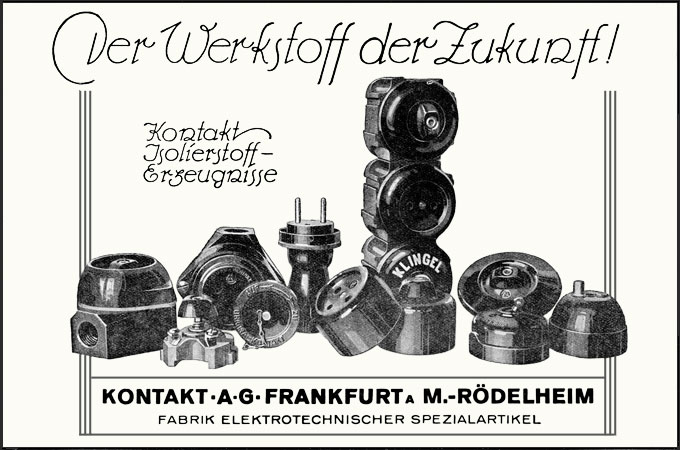 |
Kontakt AG Frankfurt am Main |
locking plugs |
3-phase |
| Prior
to the introduction of IEC 60309 electro-technical companies
produced their own models of three-phase plugs and sockets. A special,
lockable type with built-in switch, designed by the German company
Kontakt AG, Fabrik elektrotechnische Spezialartikel is shown below. When Kontakt has been founded is not clear, but the oldest patent found dates back to 1921. From late 1920s there was a close cooperation with H. Römmler AG in Spremberg (Brandenburg), a company specialized in producing Bakelite and steatite parts, ordered by electro-technical companies. In 1930 Kontakt AG was taken over by Brown-Boveri Cie and merged with Stotz & Cie, a subsidiary of BBC since 1918. |
 |
 Lockable, three-phase plug, rated at 15A - 380V. The matching socket is shown below in figure 3a. |
 |
| 1, 2 |
The
plug has been made by Kontakt AG in Frankfurt am Main. The KAG logo was
used
until the merge with Stotz & Cie in 1930 (see introduction above).
It is likely that the design dates back to the late 1920s. Production
continued until the late 1930s (see caption to figure 3). More
information about the plug is given below. MPAD mark 32-S and the HRS logo indicate that the Bakelite cast and possibly also the steatite switch unit (fig. 3b) have been made by H. Römmler AG in Spremberg. |
| 3 | Figure 3
appeared in a 1937 Stotz-Kontakt Export List. Text in grey has been
added by Oof Oud. The catalog entry also described how to use the Verriegelbare, abschaltbare Steckvorrichtung (lockable plug device with switch). Translated into English: "The housing of the socket contains a completely in steatite encapsulated two* or three pole switch. To turn an inserted plug on, it has to be rotated by 55° to the right**. Turning the plug to the left switches the connection off and enables pulling out the plug. The socket is intended for motor vehicle garages, gas stations and similar purposes. However, it must not be used in areas where additional protection is required to minimize the risk of explosions; for example in mines and similar underground facilities." * A 15A - 250V single phase model has existed also. ** The guides - indicated by green arrows in image 2 - lock the rotated plug. The unequal size of the guides ensures that the plug can be inserted in only one position. The four peripheral pins have a diameter of 6 mm and are 10 mm long. Length and diameter of the hollow central pin are 7 mm. The central pin is marked as E; it must be the neutral pin. The cord has four wires; the central pin is not connected to any of the wires. A neutral connection is not necessary in case of a balanced (L1, 2, 3) load. The position of L1, L2, L3 and protective earth are not indicated. In particular the correct wiring of the S (protective earth) connection is essential. The top pin in image 2 is different. For single phase plugs, pins with two grooves have been used in Germany in the 1930s for application that were taxed according to a domestic tariff (rather than lighting or commercial tariff). The different shaped pin on a three-phase plug must have had another meaning, possibly the protective earth connection. I am grateful to Reiner Hahn for donating this rare plug and adding essential information. |
 |
| 1928 advertisement for Kontakt AG
products. Der Werkstoff der Zukunft ! (raw material for the
future) refers to
Bakelite, used in Kontakt
Isolierstoff Erzeugnisse (insulated products made by
Kontakt).
{RH} |